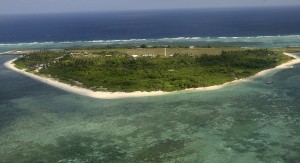MANILA, Philippines–Malacañang on Thursday said President Benigno Aquino III’s order renaming the waters within the country’s exclusive economic zone as West Philippine Sea would not require the amendment of the Archipelagic Baselines Law.
Signed by then President Gloria Macapagal-Arroyo in 2009 and upheld by the Supreme Court last year, the Archipelagic Baselines Law defines the borders of the Philippines, but does not cover the Kalayaan Island Group in the Spratly archipelago and Panatag Shoal (Scarborough Shoal) in the West Philippine Sea.
The law classifies those islands that the Philippines disputes with China as a “regime of islands” in accordance with the United Nations Convention on the Law of the Sea (Unclos).
On Sept. 5, Aquino signed Administrative Order No. 29 renaming the waters in the Luzon Sea and the waters “around, within and adjacent to the Kalayaan Island Group” and the Panatag Shoal as the West Philippine Sea.
Those areas are recognized as the Philippines’ EEZ under the Unclos.
It is not clear, however, whether the Kalayaan Island Group is within the West Philippine Sea. The Palace has yet to determine whether those islands in the Spratlys that the Philippines claims are within its EEZ.
Presidential spokesperson Edwin Lacierda pointed that out in a briefing for reporters at the Palace on Thursday. Renaming the area West Philippine Sea is a “regular step” for the Philippines in the exercise of sovereignty over what has always been its territory, Lacierda said.
Aquino’s order notes that as provided under the Unclos, the Philippines has sovereign rights “to explore and exploit, conserve and manage the natural resources, whether living or nonliving, both renewable and nonrenewable,” of the waters within its EEZ.
So, Lacierda said, there is “no need to amend the Archipelago Baselines Law.”
Renaming the waters within the Philippine EEZ reinforces the country’s claim to the Kalayaan Island Group in the Spratlys and the Panatag Shoal off Zambales province, Lacierda said.
The EEZ within the West Philippine Sea extends 370 kilometers from Philippine shores. Beyond that distance, the sea is known in Vietnam as East Sea. Up north, the waters are called East China Sea.
But China calls all those waters South China Sea and claims nearly the entire area, including parts of it claimed by the Philippines, Vietnam, Brunei, Malaysia and Taiwan.
Lacierda acknowledged that the Archipelago Baselines Law did not cover the Kalayaan Island Group. He said, however, that the chain was still part of Philippine territory under the regime of islands principle in the Unclos.
But reporters asked him: Is the Kalayaan group within the West Philippine Sea?
“That’s one thing that we’re verifying,” Lacierda answered.
“In fact, the President also mentioned that he is going to verify if the Kalayaan Island Group was part of that. So we’re looking at it,” he added. “We’re still verifying what part[s] are the disputed islands, [what parts are within] the West Philippine Sea.”
Later, Lacierda said in a text message that the order could not affect the Archipelago Baselines Law since an executive order cannot amend a law.
Asked during the briefing what had prompted the President to issue the order, Lacierda said the administration felt the use of the name West Philippine Sea should be “formalized” through an administrative order since governmental agencies were already using it in official discussions.
Noting that Taiwan had opposed the renaming of the Philippine EEZ, Lacierda said the other claimants should not see the Philippine decision as a provocation, as the country was not claiming the entire sea.


